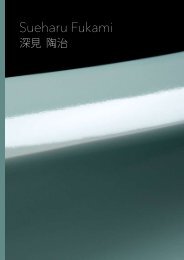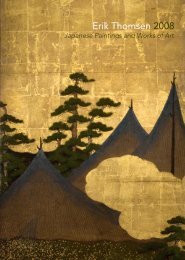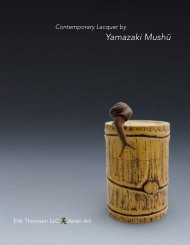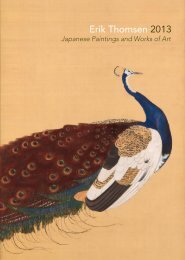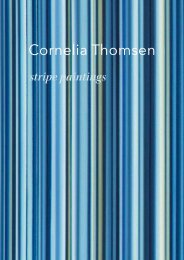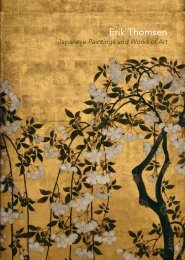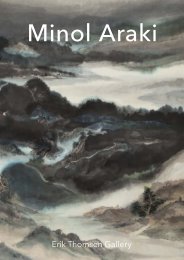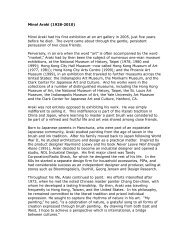View publication (pdf file 6.5 mb) - Erik Thomsen
View publication (pdf file 6.5 mb) - Erik Thomsen
View publication (pdf file 6.5 mb) - Erik Thomsen
- No tags were found...
You also want an ePaper? Increase the reach of your titles
YUMPU automatically turns print PDFs into web optimized ePapers that Google loves.
4Araki Kampo 荒 木 寛 畆 (1831–1915)Peacock Pair by CliffsMeiji period (1868 –1912), dated 1907H 76 ¾" × W 75 ¾"(195 cm × 192.4 cm)Two-panel folding screenInk, colors, gold and gold-leaf on silkSignature:Kampo 寛 畆Seals:1) »Seventy-seven year old Kampo« 七 十 七 翁 寛 畆2) »Artist name Tatsuan« 號 達 庵A majestic peacock stands on top of a craggy cliffand surveys the world around him, while his matewalks below, in the safety of his alert gaze. Thepainting was made by one of the great artists ofmodernizing Japan at the age of seventy-seven.Despite his advanced age, we sense the strengthof the artist in the dramatic brushstrokes, the clearsense of composition, and the finely delineatedtechniques. Just like the male peacock, he still verymuch rules his corner of the world.Kampo was born in Edo and started to work at anearly age as apprentice for the Araki workshop,where he showed early promise. He was eventuallyadopted into the Araki family at the age of twentytwoand became its head painter. At one time heattempted oil paintings, but eventually returned tothe Nihonga school style. Kampo specialized inpaintings of flowers and birds. He unified the variousstyles and introduced new influences and techniquesfrom the West, and taught a generation ofyoung artists, becoming an important pioneer of thenew age of painting in Meiji Japan.Remarkably, Kampo had extensive success outsideof Japan and became one of the most famousJapanese artists in the West. He entered works andwon numerous prizes at international expositions,such as Vienna in 1872, Chicago in 1893, Paris in1900, St. Louis in 1904, and London in 1910. Hewas also the first Japanese artist to become ame<strong>mb</strong>er of the prestigious Royal Society of Arts inLondon. Inside Japan, he was very active in nationalexhibitions and won numerous honors. 2 Hetaught at the Tokyo Art School from 1898 to 1908and at other universities as well. The present screenstems from the time he was teaching at the TokyoArt School.The sumptuousness and vitality of the peacock arereflected in the rich gold-leaf ground and in thefine details Kampo added with gold wash on topof the ink. He also added light colors to give depthto the plumage of the birds and drew the rocksand the ba<strong>mb</strong>oo with an array of textured strokesand ink wash techniques. In all these aspects, thepainter goes back to a long tradition of peacockpaintings on gold ground, such as those createdby the Maruyama and Kishi Schools. 122 23



